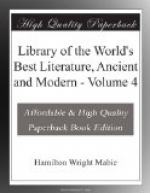Walter Besant, born in Portsmouth, England, in 1838, did not begin his career as a novelist till he was thirty years old. His preparation for the works that possess so certain a maturity of execution, with as certain an ideal of performance, was made at King’s College, London, and afterwards at Christ’s College, Cambridge, where he took mathematical honors. Abandoning his idea of entering the Church, he taught for seven years in the Royal College of Mauritius. Ill health compelled his return to England, and he then took up literature as a profession. His first novel he had the courage to burn when the first publisher to whom he showed it refused it.
But the succeeding years brought forth ‘Studies in Early French Poetry,’ a delicate and scholarly series of essays; an edition of Rabelais, of whom he is the biographer and disciple, and, with Professor Palmer, a ‘History of Jerusalem,’ a work for which he had equipped himself when secretary of the Palestine Exploration Fund.
[Illustration: WALTER BESANT]
Mr. Besant was also a student in another special field. He knew his Dickens as no other undergraduate in the University knew that branch of polite literature, and passed an examination on the ‘Pickwick Papers’ which the author declared that he himself would have failed in. By these processes Mr. Besant fitted himself mentally and socially for the task of story-telling. The relations of a man of letters to the rest of the world are comprehensively revealed in the long list of his novels.
From the beginning he was one who comes with a tale “which holdeth children from play and old men from the chimney corner”; nor is the charm lessened by the sense of a living and kindly voice addressing the hearer. His novels are easy reading, and do not contain an obscure sentence. As art is an expression of the artist’s mind, and not a rigid ecclesiastical canon, it may be expressed in as many formulas as there are artists. Therefore, while to few readers life casts the rosy reflection that we have learned to call Besantine, one would not wish it to disappear nor to be discredited.
It was in the year 1869 that Walter Besant, by a happy chance, made the acquaintance of James Rice, the editor of Once a Week, and became a contributor to that magazine. In 1871 that literary partnership between them began, which is interesting in the history of collaboration. Mr. Rice had been a barrister, and added legal lore to Mr. Besant’s varied and accurate literary equipment. The brilliant series of novels that followed includes ‘Ready-Money Morti-boy,’ ‘My Little Girl,’ ’With Harp and Crown,’ ‘The Golden Butterfly,’ ‘The Seamy Side,’ and ’The Chaplain of the Fleet.’ The latter story, that of an innocent young country girl left to the guardianship of her uncle, chaplain of the Fleet prison, by the death of her father, is delicately and surprisingly original. The influence of Dickens is felt in the structure




